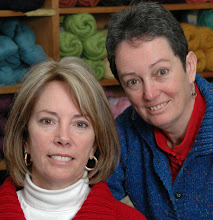Sizing is a challenge to designers writing patterns. And I agree with Sharon (last post comment) that a plus sized pattern should include bust darts, etc to make the fit better. The added challenge for working from the top down is to get the number of stitches needed for the body without huge sleeves and a deep yoke. I have been experimenting with these ideas behind the scenes for a while and am almost convinced I could take on the challenge. I have been working up to it and now have a couple of plus sized women who will help with the sizing and garment knitting.
I get asked about resizing, especially for childrens' patterns, quite often. Generally I suggest a change of yarn. Working the sweater in a different gauge of yarn will make the sweater bigger (thicker yarn) or smaller (finer yarn). This works if the size needed doesn't stray too far past the size the pattern is written for because the change of size is proportional. If the change of gauge makes the sweater body 10% bigger then it is 10% bigger everywhere. The sleeves, neck opening, cuffs, etc are all 10% bigger. Up-sizing for plus sizes this way doesn't work as well. The change of gauge doesn't account for the smaller changes in the back of neck measurement and the sleeve width as you work the larger change in body size. Complicated! That is why I think dedicated patterns for sets of sizes work best and the up-sizing of smaller patterns doesn't work as well. But that brings us back to the small number of plus sized patterns available. Around and around we go. I'll use this as a push to get some of my ideas fine-tuned and down on paper.
Have you had success up-sizing patterns?
Deb
Subscribe to:
Post Comments (Atom)


Deb, I think top-down raglans are probably the most difficult style to upsize. When I designed "Sandridge" I had to spend a crazy amount of time working on spreadsheets manipulating the proportions in order to go from size 32 to size 52. The whole matter was made more complicated by the fact that the design had cables which meant that the body had far more stitches to start with than one would normally have. My solution was to work things out so that in the smaller sizes there were no underarm cast-on stitches while for the larger sizes there were. With non-raglan designs you don't have the same problem with geometric progression. So, maybe one solution is to try out top-down designs that aren't raglans (radical thought!)
ReplyDeleteI think the same goes for the very small sizes. I have a couple of customers who are very narrow, almost no bust. They complain that all they can find in their size is kids patterns, or sometimes teen ones, but they don't necessarily look appropriate on a woman in her 50's!! I guess the opinion there is that if you are a 30" bust or smaller, you can't be an adult!
ReplyDeleteMarianne